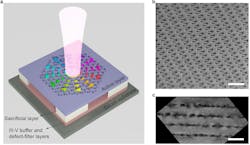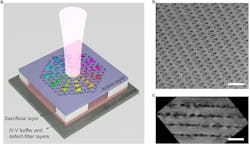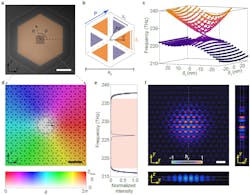Dirac-vortex topological lasers meet silicon
An international team of researchers has experimentally demonstrated room-temperature continuous-wave Dirac-vortex topological lasers at a telecom wavelength from indium arsenide/indium gallium arsenide (InAs/InGaAs) quantum dot materials monolithically grown on an on-axis silicon substrate—and it shows enormous potential to bring topological robustness to next-gen silicon photonic integrated circuits.
While silicon is a great material for modulating, waveguiding, and detecting photons, so far integrating high-performance lasers onto silicon is an elusive holy grail for researchers. It’s a roadblock because silicon remains the most prevalent material for nanophotonics and microelectronics today.
Why is the team’s work a big breakthrough? It proves topological lasers monolithically integrated on a silicon substrate (see Fig. 1) can operate at room temperature continuous-wave conditions, which moves researchers a step closer to being able to use topological lasers for silicon nanophotonic and microelectronic platforms.
“Seven years ago, our collaborator Siming Chen’s team at University College London developed the technology of monolithic integration of III-V quantum dot lasers on silicon,” says Xiankai Sun, an associate professor of electronic engineering at The Chinese University of Hong Kong, as well as an associate director of its Center of Optical Sciences. “But most existing quantum dot cavity lasers are quite sensitive to the variation of cavities, which fundamentally limits their performance.”
The concept of topology, which originated within the realm of mathematics, recently found its way into the realm of optics and laser design. And the Dirac-vortex state, a mathematical analog of the well-known Majorana fermions (angel particles) within superconducting electronic systems, is being tapped by the team as a way to provide tight and robust confinement of classical waves.
“One of the advantages it offers within the optics domain is that it has a fundamentally larger free spectral range than that of conventional optical cavities,” says Sun. “We believed this important feature could be harnessed to achieve robust single-mode surface-emitting lasers on silicon.”
Design and fabrication of Dirac-vortex photonic crystal lasers
The researchers designed and fabricated their Dirac-vortex photonic crystal lasers (see Fig. 2) by exploiting an auxiliary orbital degree of freedom in topological insulators. Their microcavity is based on a topological Dirac-vortex state created within a photonic crystal slab structure.
“We designed and fabricated our Dirac-vortex photonic crystal lasers by harnessing an auxiliary orbital degree of freedom we discovered a couple of years ago in nanomechanical topological insulators,” says Sun.
This auxiliary orbital degree of freedom allowed the researchers to control the near-field of the Dirac-vortex cavities to obtain linearly polarized far-field emission, after which they observed vertical laser emission from these Dirac-vortex microcavities under continuous-wave optical pumping at room temperature.
“Our lasers exhibit fundamentally different properties than their counterparts,” says Sun. “First, their lasing wavelength is quite robust against the varied cavity size, because the lasing wavelength is topologically pinned to the Dirac point. Second, their free spectral range defies the universal inverse scaling law of free spectral range (FSR): FSR ∝ V−1, where V is the cavity modal volume. These unique properties make our lasers fundamentally different from previous lasers with conventional cavity designs (see Fig. 3).”
Importantly, since the team’s laser defies the universal scaling law with the cavity size, it’s complementary metal-oxide semiconductor (CMOS)-compatible for on-chip photonic and optoelectronic systems.
One of the main challenges along the way for the researchers was that a suspended-membrane configuration they used resulted in their laser cavities having experimental limitations achieving a large-size (hundreds of microns and beyond) photonic crystal slab.
“The limited cavity size results in a relatively low cavity quality factor because of the relatively weak in-plane optical confinement provided by the bandgap of the surrounding photonic crystal,” says Sun. “This challenge should be overcome in the design and fabrication of our next-gen Dirac-vortex laser devices.”
Numerous applications ahead
The creation of Dirac-vortex quantum dot lasers holds promise as an on-chip light source for next-gen silicon-based photonic integrated circuits, and also makes it possible to explore topological phenomena such as non-Hermiticity, bosonic nonlinearity, and quantum electrodynamics—all of which will enable advances within the field of optoelectronics and pave the way for more efficient and robust communication technologies.
The team’s Dirac-vortex lasers may be used in applications “such as transmitters within fiber-based or free-space communication networks, light sources in LiDAR or face-recognition systems, and chemical or biomedical sensors,” says Sun.
And because “lasers inherently exhibit non-Hermiticity and bosonic nonlinearity, our results enable further exploration of new physics in the Majorana bound state that has no counterpart within the electronic domain,” Sun adds. “By reducing the density of the InAs/InGaAs quantum dots so each Dirac-vortex cavity contains only one quantum dot, our devices provide an additional strategy for exploring the interplay between topology and quantum electrodynamics.”
Since the optically pumped lasers still have limited applications, the researchers’ next step is to build an electrically pumped topological Dirac-vortex laser that can be used for a topological photonic integrated circuit.
FURTHER READING
J. Ma et al., Light Sci. Appl., 12, 255 (2023); https://doi.org/10.1038/s41377-023-01290-4.
About the Author
Sally Cole Johnson
Editor in Chief
Sally Cole Johnson, Laser Focus World’s editor in chief, is a science and technology journalist who specializes in physics and semiconductors.




